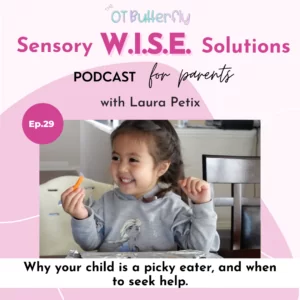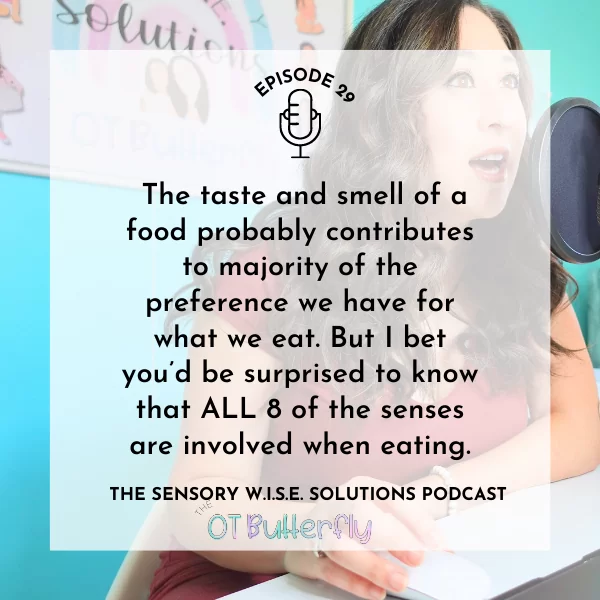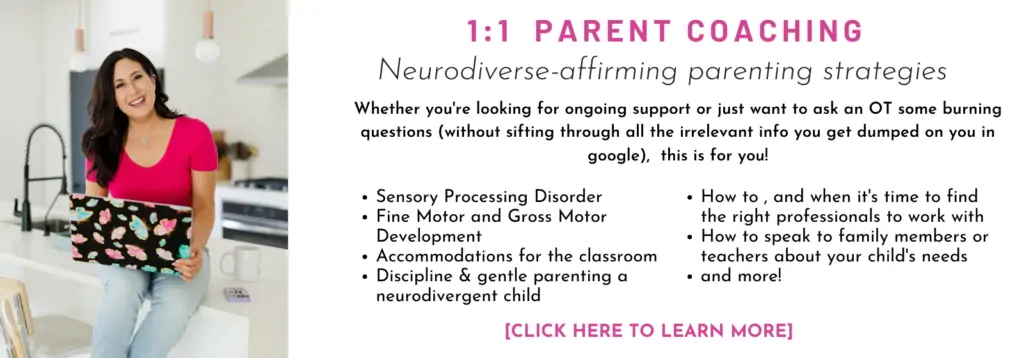Get your FREE sensory profiles cheat sheet >>click here<<
Why your child is a picky eater, and when to seek help.
Raise your hand if you have a child who eats anything you put on their plate, with no question, no fusses, and smiles through it all. If you’re raising your hand right now, I’m sorry to say but you’re in the wrong place.
If you didn’t raise your hand, you’re not alone. Most parents deal with a picky eating phase, but some parents’ journey with their child’s picky eating is a little more severe than others, and we’re going to cover it all today.
We’ll talk about the skills that build the foundation for eating, how sensory processing is related to picky eating, how OT helps picky eating, and lastly when it’s time to seek support from an OT.
Prerequisite skills for eating
It’s important to first mention that to OTs (and probably Speech therapists as well), the act of feeding and eating are 2 separate things.
When we refer to feeding, we’re thinking about bringing the spoon or your hand to your mouth, being able to scoop the rice up and bring the cup to your mouth.
When we talk about eating, we talk about food manipulation, chewing, swallowing, including the types of food a person eats. For this episode, I’m focusing on the act of eating, with a specific focus on kids who have a limited diet or are otherwise referred to as picky eaters or selective eaters.
So what skills and parts of development contribute to how a child eats and what they actually eat? I’m so glad you asked! Let’s break it down.
Gross motor skills and eating
Yes, you read that right, gross motor skills contribute to eating. Think about the first milestone that’s required before feeding your child solids: the ability to hold their head upright and sit up with minimal support.
Postural strength and endurance is a huge contributing skill to have for eating.
A child with weak postural strength or endurance would have a hard time sitting up at the table, maybe always leaning their head down, or prefer to stand and eat rather than sit at the table.
A note on postural strength: it actually takes a lot less postural strength for a child to stand up and eat rather than sit in one spot and maintain an upright position. Sometimes we see a lot of “drive by eating” when a child prefers to walk by, grab a bite of food and then go back to moving around. Obviously, this could also be related to vestibular seeking (which we’ll talk about in a second).
Fine motor skills and eating
When I say fine motor skills, you might be thinking of handwriting and grasping beads, but did you know that chewing and swallowing and moving food around with your tongue also counts as fine motor skills?
When it comes to oral motor development (muscles movements in the mouth and tongue), speech language pathologists are the main experts in this area. But we (feeding therapists, OTs) do know that the way a child’s oral motor skills develop are a major contributor to foods that they eat and foods that they choose not to eat.
For example, if a child has difficulty with properly manipulating and chewing and swallowing certain textures or foods, this may make them avoid certain foods.
A lot of time, we see children who are picky eaters only seating a specific texture of food, like: yogurt, oatmeal, icecream, soups, etc. When we see that the foods they do prefer to eat all have the same texture, it alerts us (by us, I mean feeding therapists, OTs, SLPs) that they may have an oral motor challenge, where their tongue and movement of their jaw for chewing can only tolerate textures that are easy to manipulate and chew in their mouth.
They tend to avoid textures that require more advanced chewing, like chicken breast, or mixed textures like a sandwich or fried rice. So, it’s really important to consider this and that picky eating doesn’t just always stem from the taste of food.
Please note that I am not certified in any advanced training on oral motor skills assessment or development. Click here to learn more about oral motor development.
Grasp is another fine motor skill that’s important for both feeding and eating. One of the first fine motor grasp patterns we see with relation to feeding is the pincer grasp. This is the grasp we see when a child picks up a cheerio or a pea with the tip of their index finger and thumb. If this skill is delayed, it can impact the foods that your child explores.
There’s also grasp that’s associated with using feeding utensils or other hand held foods that may impede a child’s ability to enjoy certain foods.
Sensory processing skills for eating
If you had to name what senses contribute to eating, you’d probably name taste and smell first. That makes sense, the taste and smell of a food probably contributes to majority of the preference we have for what we eat. But I bet you’d be surprised to know that ALL 8 of the senses are involved when eating.
Yes, you heard me right, there are 8 senses (read about them more in depth here)
Since taste and smell are pretty obvious contributors to picky eaters, let’s focus on some of the behind the scenes players here.
- Vestibular processing: This is the sense in your inner ear that processes movement, and contributes to balance, posture and bilateral coordination. As I already mentioned, you do need strong postural muscles in order to sit upright to properly chew and swallow your food. A solid vestibular sense contributes to that. Also, vestibular processing can be related to attention and level of alertness, which is definitely needed at the table.
- A child with vestibular processing issues may have a hard time sitting still at the table, always rocking back and forth or constantly getting up from the table (aside from “typical preschool/toddlers”)
- Proprioceptive processing: This is the sense that gets activated from muscles, tendons and joints and is responsible for developing body awareness. This can help a child know how to bring the food to their mouth. The proprioceptive sense also contributes to postural awareness and sitting upright in combination with the vestibular system.
- A child who doesn’t feel fulfilled with their proprioceptive sense might always kick their feet against the chair legs at the table, or may really seek out really crunchy or chewy foods at the table (and you may also see them chew non-food items when they’re not at the table).
- Interoceptive processing: This is the sense responsible for recognizing hunger and fullness cues, so as you can imagine- this is extremely relevant for eating.
- Visual processing: A child needs to be able to not only see what’s on their plate, but also manage all the competing visuals that they see in their environment and on their plate. Some children may be extremely sensitive to visual input like colors or bright lights, so if the environment has something that’s triggering them, they may exhibit some behaviors at the table completely unrelated to the food, but still impacts their appetite or ability to focus on a meal.
- Tactile processing: This is the touch sense and as you can imagine, can definitely impact how a child explores and behaves around food. The most common impact it can have is tolerating the way different food textures feel on their tongue, in their mouth, on their hands or on their face. I know my daughter sometimes will completely refuse to eat a certain food even if she loves it unless I feed her because she does not want to make a mess. As you can imagine, this usually brings about some extra emotions when I’m just so stressed and exhausted and don’t feel like spoon feeding my almost 5 year old, I know many of you can relate!
- Auditory processing: Sound can actually play a huge role in eating, and not JUST in the annoying “stop crunching so loud” way, though that is one aspect of it. Think of all the clinks and clanks from utensils on plates, table chatter, electronics if they’re at the table, dogs barking, babies crying, and all of the extra sounds especially in places like a restaurant or the school lunch room. When a child has sensory sensitivities and they get triggered or overwhelmed by sound, it can trigger their stress response as they become dysregulated. Guess what happens with the stress response? Cortisol gets released and can act as an appetite suppressant in some people.
Was any of that surprising to you? Eating is not that simple! And if you have a picky eater, chances are they may have a mix of these things going on, it may not just be that they are picky about the taste of things.
What does OT support look like for picky eaters?
Now that you understand all the behind-the-scenes players in eating, let’s talk about how this plays out in OT.
If your child has some of the gross motor postural control challenges I mentioned (remember, this is what helps your child sit up at the table, which is necessary to help with food chewing and digestion) then an OT would do a lot of core strengthening exercises and activities.
This could be anything from an obstacle course, to sitting on an exercise ball while playing a board game at the table. They might have your child sit on a swing or kneel on an unstable platform trying to maintain balance while hitting a balloon or popping bubbles.
If your child has any of the fine motor challenges associated with eating, your OT might set out some dry sensory bins with a lot of scoopers and tongs and things to pick up tiny pieces with it.
If your child has oral motor chewing challenges (which again, is a fine motor skill) speech therapists are usually the one to help with this specific issue, or an OT with a specialized advanced certification in oral motor development.
For any of the sensory processing challenges, your OT may do a mix of obstacle courses, sensory integration and sensory play, maybe some listening program with music for regulation.
In addition to these interventions, OTs also directly support the child in the eating environment through two ways: accommodations and therapeutic feeding techniques.
Environmental Accommodations for Picky Eaters
One of the first things an OT will look at if you have a picky eater is your eating environment and the way your child is positioned for sitting at the table.
The optimal sitting position for eating is what we call the 90-90-90 position, which is when a child’s hips, knees and ankles are all flexed at 90 degrees. Think of a child’s back being upright, their knees bent over the edge of the chair, and their feet planted firmly and parallel to the ground. So an OT might offer back support or a foot stool to help make this happen.
The OT may also help you adjust the seat at the table or the environment if there are any other sensory components to the environment that’s contributing to picky eating.
Feeding therapy for picky eaters
In addition to some of the sensory integration, fine motor and gross motor interventions, there is an actual curriculum of feeding therapy that an OT would use with you and your child.
Parent coaching and education should always be part of feeding therapy because you really do need to be on the same page with language and food offering at home in order to carry over any progress made in therapy.
Feeding therapy may look different depending on which method your OT is trained on, but one of the most common ones, and what I consider the gold standard of feeding therapy is called SOS, so you can check with your OT if they’re certified in SOS feeding approach.
It’s an approach that emphasizes purposeful play and safe exploration with food using a step-wise progression in a way that meets the child where they’re at. It involves a specific curriculum for introducing certain foods based on the child’s current food repertoire and adds foods based on a certain hierarchy and sensory characteristics. It is research based and I have had so much success working on this with my clients in direct therapy as well as coaching parents through it virtually.
When it’s time to seek OT for picky eating
OK, so you might be thinking “my child is a picky eater, but do I need an OT for this?”
My first answer as for any childhood development behavior or concern is about you, the parent.
How impacted are you in your daily life by this behavior/challenge with your child?
Maybe you’re a nutritionist or a teacher and you have a picky eater but you have enough tools under your belt to get creative and make it by. Or, maybe you’re an accountant or a stay at home mom and feel completely helpless and are desperate for help, this keeps you up at night and you just don’t know what to do.
There’s no harm in checking in with an OT.
But if you want some more tangible criteria for looking into feeding therapy for your child, here you go:
- Less than 20 various foods in their repertoire (chicken nuggets and chicken breast count as 2 different foods, by the way)
- If they have one single food group that they don’t have any safe foods in (e.g. no protein at all, or no fruits/vegetables,)
- If there is a weight or nutritional intake concern brought up from the pediatrician
- If they keep dropping their safe foods and aren’t able to eat them anymore
If any of that is happening with your child, OT can be a great place to start to seek help.
If you know you want to look for an SOS feeding specialist in your area, you can actually head straight to sosapproachtofeeding.com and head to the parents category, then you can search by location to find a service provider in your area.
You can also call around to local OT clinics, I usually recommend asking local parenting or mom groups on facebook or other community support groups you have to see if anyone recommends a certain OT clinic and just cold call clinics until you find one that takes your insurance, if you’re going that route, or if you can pay cash, there are a lot of clinics that offer private pay.

OT clinics can have huge waitlists, but if you’re desperate for help and to get started supporting your child at home with picky eating, I can help! I offer 1:1 consultations via zoom, head to www.theotbutterfly.com/parentconsult to learn more.
Episode Links:
Transcript/show notes at www.theotbutterfly.com/29
instagram: @TheOTButterfly www.instagram.com/theotbutterfly
email: LauraPetix@TheOTButterfly.com
work with me: www.theotbutterfly.com/parentconsult








